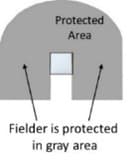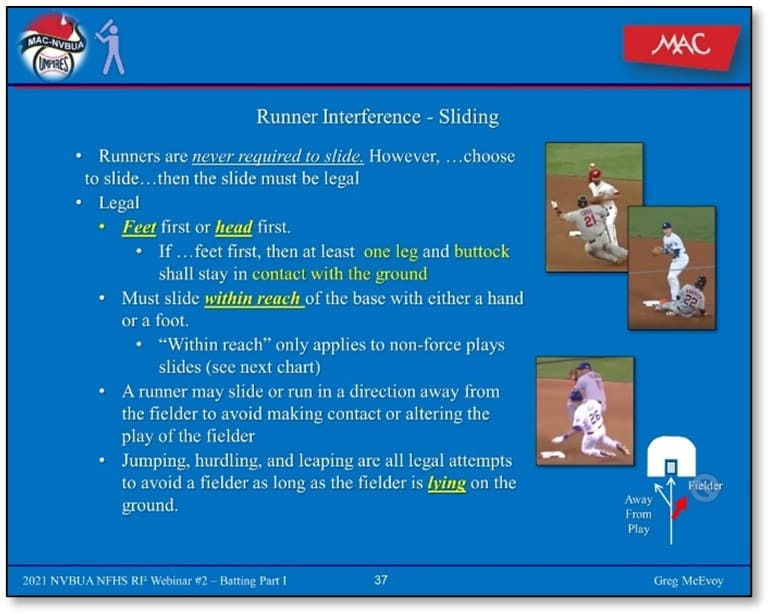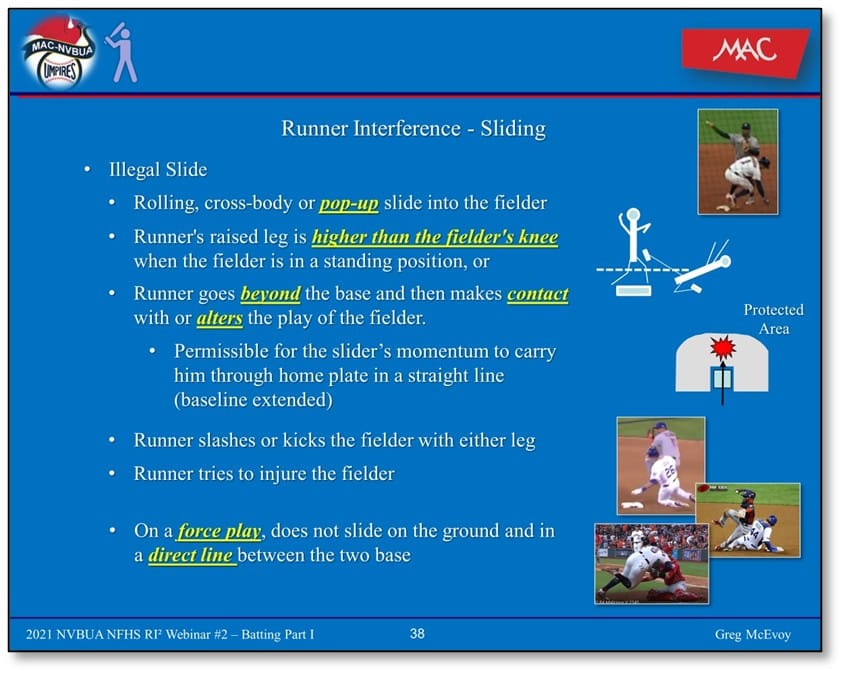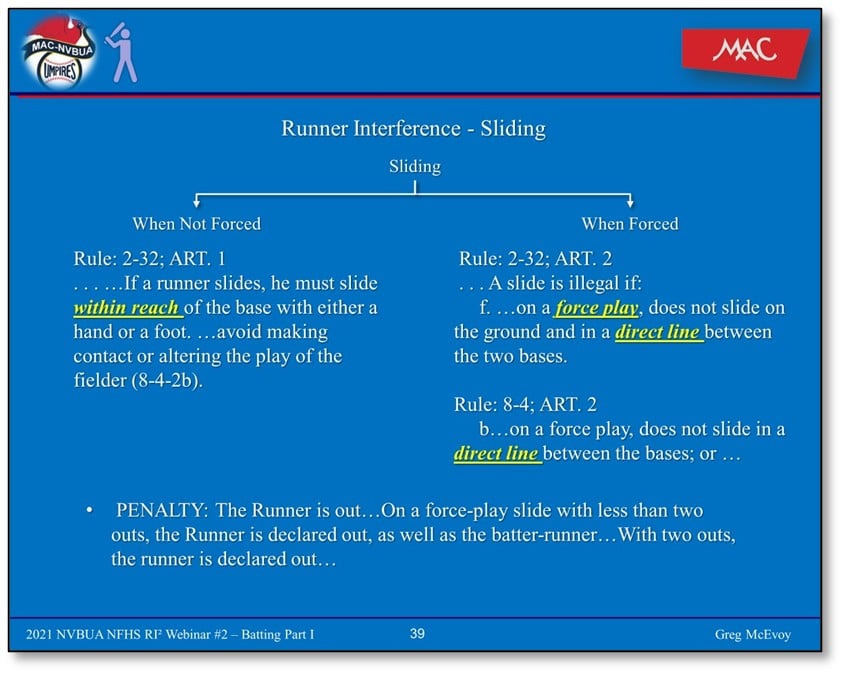Illegal Slide
Introduction
Umpiring collision plays is one of our more challenging umpiring calls we make. NFHS and State Associations place great emphasis on player safety. Although HS baseball playing rules are in place to prevent, discourage and penalize these situations, some collisions still happen to include:
- Errant throw to 1st, F3-BR collision at 1st
- Runner-F2 collision at home plate)
- Fielder-Runner collision during a slide into a base
Collision plays require umpires to determine who is at fault:
- Did offense initiate/cause the collision
- Did the defense initiate/cause the collision
- No fault on either the offense or defense
- And, what is malicious contact
Let’s take a look at one example of a collision –slide play into a base
- R1, ground ball to 3rd, potential 2nd to 1st double play
- R1 slides hard into 2nd, makes contact with Fielder who is standing on the ground on the outside of the bag, contact is beyond the bag
Umpiring Components of the Play
- Was R1 slide legal
- Was R1 contact malicious
- Possible no possession safe call vs. out call on the transfer
- Is there a possible second out
- Are you prepared for a possible Fielder-Runner confrontation
Discussion
- Remember to observed the “entirety of the play” to best comprehend what you are observing
- In HS baseball, “U” shaped “protection zone” surrounds the Base to protect fielders from injury from runner contact (major safety rule)



- Protection zone exists for ALL bases
- Exception, a player may slide beyond home plate and make legal contact with F2
- Contact is legal in front of the bag as long as it’s not malicious
- A runner is never required to slide but if he does the slide must be legal
- Two fundamental sliding requirements:
- Non-force slide play – within reach of the bag
- Force slide play – Runners are required to slide directly into the bag
What’s the call
Since R1 slid beyond the bag and made contact with the fielder, that is an illegal slide. Immediate dead ball and R1 is out.
Is that all…no.
Is the BR safe or out?…I would have called the BR out. The illegal slide was intentional and is a violation of the NFHS force play slide rule as outlined in Rule 2-23. For me, the R1 collision on the runner negates any consideration regarding “transfer.”
Are we done? Well, not necessarily.
Did R1 slide directly into the bag or into the fielder? For me, I believe R1 was intentionally going after the fielder rather than attempting to reach 2nd (a critical distinction). Because of the intent (judgement) and high risk of injury, for HS baseball I would also call this malicious contact and eject R1.
Now we are done? Nope.
Be prepared for an appeal and possibly prevent/intervene an any possible conflict that might arise. Judgement calls are not appealable, however, a coach can appeal the miss-application of a rule. For this play, this was purely a judgement call. As a reminder, when appealing, all Coach-Umpire conferences shall be conducted at the respective 45 foot line.
Applicable Rules
Rule 2-23 SECTION 32 SLIDE
ART. 1 – A legal slide can be either feet first or head first. If a runner slides feet first, at least one leg and buttock shall be on the ground. If a runner slides, the runner must slide within reach of the base with either a hand or a foot. A runner may slide or run in a direction away from the fielder to avoid making contact or altering the play of the fielder. (8-4-2b)
ART. 2 – A slide is illegal if:
- the runner uses a rolling, cross-body or pop-up slide into the fielder; or
- the runner’s raised leg is higher than the fielder’s knee when the fielder is in a standing position; or
- except at home plate, the runner goes beyond the base and then makes contact with or alters the play of the fielder. At home plate, it is permissible for the runner’s momentum to carry through the plate in a straight line (baseline extended); or
- the runner slashes or kicks the fielder with either leg; or
- the runner tries to injure the fielder; or
- the runner, on a force play, does not slide on the ground and in a direct line between the two bases.
A. Runs more than three feet away from a direct line between bases to avoid being tagged or to hinder a fielder while the runner is advancing or returning to a base;
- This is not an infraction if a fielder attempting to field a batted ball is in the runner’s proper path and if the runner runs behind the fielder to avoid interfering with the fielder.
- When a play is being made on a runner or batter-runner, the batter-runner’s baseline is established as directly between the batter-runner’s position and the base toward which the batter-runner is moving.
B. Does not legally slide and causes illegal contact and/or illegally alters the actions of a fielder in the immediate act of making a play, or on a force play, does not slide in a direct line between the bases; or
- A runner may slide in a direction away from the fielder to avoid making contact or altering the play of the fielder.
- Runners are never required to slide, but if a runner elects to slide, the slide must be legal. (2-32-1 , 2-32-2) Jumping, hurdling, and leaping are all legal attempts to avoid a fielder as long as the fielder is lying on the ground. Diving over a fielder is illegal.
PENALTY: The runner is out. Interference is called and the ball is dead immediately. On a force-play slide with less than two outs, the runner is declared out, as well as the batter-runner. Runners shall return to the bases occupied at the time of the pitch. With two outs, the runner is declared out. The batter is credited with a fielder’s choice.
C. Does not legally attempt to avoid a fielder in the immediate act of making a on the runner; or
PENALTY: The runner is out, the ball remains live unless interference is called.
D. Dives over a fielder; or
PENALTY: The runner is out and the ball remains live unless interference occurs and is declared.
E. Initiates malicious contact;
- Malicious contact always supersedes obstruction. Runner(s) will be awarded appropriate base(s) per umpire’s judgment.
F. As a runner or retired runner, fails to execute a legal slide, or does not attempt to avoid the fielder or the play on a force play at any base; or
G. Intentionally interferes with a throw or a thrown ball; or the runner hinders a fielder on the fielder’s initial attempt to field a batted ball. A fielder is not protected, except from intentional contact if the fielder misplays the ball and has to move from the fielder’s original location; or the runner’s being putout is prevented by an illegal act by anyone connected with the team (2-21- 1, 3-2-2, 3-2-3) or by the batter-runner; for runner returning to base (8-2- 6); and for runner being hit by a batted ball (8-4-2k). If, in the judgment of the umpire, a runner including the batter-runner interferes in any way and prevents a double play anywhere, two shall be declared out (the runner who interfered and the other runner involved).
Click on image to enlarge.



